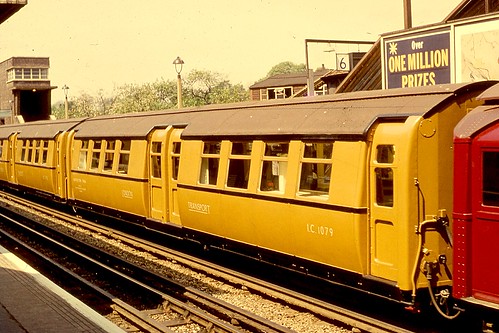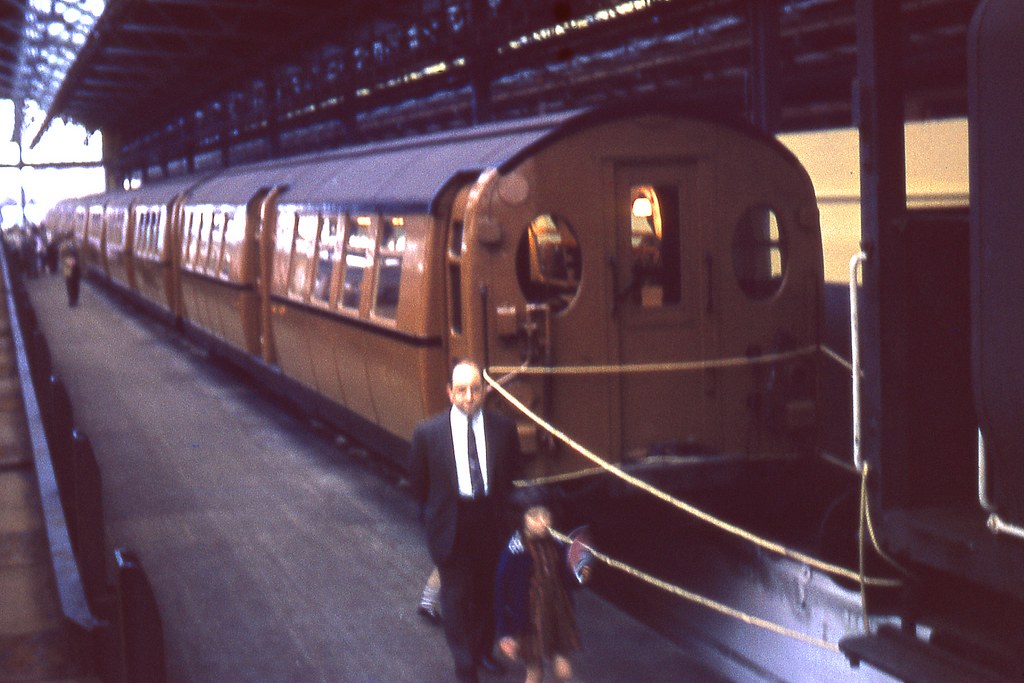rincew1nd
Administrator
Junior Under-wizzard of quiz
Posts: 10,286 
|
Post by rincew1nd on Feb 4, 2017 0:14:59 GMT
I thought the ones from spa valley went to the Buckinghamshire railway centre? Or am I getting confused with something else. No your not getting confused the T stock are no longer at the Spa Valley Railway. Apologies, I trusted the Wikipedia article linked above.  Where are they now? If only we had someone in our membership that is involved in editing Wikipedia....  |
|
DWS
every second count's
Posts: 2,487
|
Post by DWS on Feb 4, 2017 1:10:08 GMT
No your not getting confused the T stock are no longer at the Spa Valley Railway. Apologies, I trusted the Wikipedia article linked above.  Where are they now? If only we had someone in our membership that is involved in editing Wikipedia....  The former 2 coach sleet unit of T Stock was moved from store at the Spa Valley Railway to the Buckinghamshire Railway Centre at Quainton Road by road , over two days -18/20 December 2015 This move was reported in the January 2016 issue of Underground News ( magazine of the London Underground Railway Society ). |
|
Chris M
Global Moderator
Forum Quizmaster
Always happy to receive quiz ideas and pictures by email or PM
Posts: 19,766
|
Post by Chris M on Feb 4, 2017 1:19:15 GMT
Wikipedia is only ever as reliable as the sources it cites. In this case the article on the Sleet locos mentions, without a source that they were (top)/are (lower down) at the Spa Valley.
The article on the T stock states, without a source, that they were at the Spa Valley and are now at Quainton.
The articles on both the Quainton and Spa Valley railways do not appear to mention sleet locos or T stock.
If you (or anyone) has a reliable source to update the articles with then you can do it yourself, it's not hard!
|
|
|
|
Post by Dstock7080 on Feb 4, 2017 5:09:58 GMT
, I recall a photo from a depot open day, possibly Neasden 1963, which showed some venerable tube stock in use as an engineering training set-up. I don't recall the caption and I'm not sure if it was CLR stock, but it's a great shame nothing from it was saved. Probably Standard Stock from the 1920s or 1930s if it was as late as 1963. There was plenty of that knocking about in the early sixties, recently displaced by 1959/62 stock on the Picadilly and Central lines. Some cars were converted for use with 1960 stock and on the Isle of Wight, and one or two have been preserved. I think you are referring to the London Transport Instruction Train which appeared in the parade of 1963 as: Ballast Motor Car L66 – IC1075 – IC1076 – IC1077 – IC1078 – IC1079 – Ballast Motor Car L71. Not Standard Stock.  ©FW Ivey ©FW Ivey |
|
|
|
Post by norbitonflyer on Feb 4, 2017 8:16:12 GMT
I think you are referring to the London Transport Instruction Train which appeared in the parade of 1963 as: Ballast Motor Car L66 – IC1075 – IC1076 – IC1077 – IC1078 – IC1079 – Ballast Motor Car L71. Not Standard Stock. Those are "Cammell Laird" trailers from 1920, and it is indeed a pity none of these - the first Tube stock with air-operated doors - survive. They shared with the F stock on the District the distinctive feature of oval cab windows.  Built for the Picadilly Line, to operate with older motor coaches converted from "Gate" stock. Delays in converting the latter meant that the last examples entered service at about the same time as the first Standard stock, in 1923. (They were stored on the spare track of the Aldwych branch) Some were loaned to the Central London Railway in 1926 whilst its own rolling stock was being converted to air door operation. They were converted to work with Standard Stock motor coaches in 1931. Being unsuitable for operation on the Picadilly's long open air sections they were transferred to the Bakerloo, where they only operated south of Queens Park, but were withdrawn as 1938 stock came into service. They were destined next for the Northern City Line, but found to be out of gauge. Most were put into store, but several found non-railway use as mess rooms and the like, and apart form the five cars forming the instruction train, all were scrapped at the end of the War. My source (Brian Hardy's book) does not record the ultimate fate of those last five cars, but they would be in far from original condition by 1963. |
|
|
|
Post by ted672 on Feb 4, 2017 15:55:58 GMT
Thanks for the info on the Engineer's Instruction Train, most interesting.
|
|
|
|
Post by spsmiler on Feb 4, 2017 18:47:33 GMT
I almost fell off my chair (in shock) on seeing these photos of the Cammell Laird tube cars. I do not recall ever having seen colour photos of these before, nor a view showing the oval car end windows. I looked through some books on my bookshelf and found one that has a monochrome side photo and the text below is based upon the image caption. The 1948 - 1969 London Transport Instruction Train comprised "Cammell Laird" tube cars from 1920. Built for the Piccadilly Line there were twenty trailers and twenty control trailers. This was the first Tube stock to be built with air-operated doors. At first traction came from twenty French gate stock motor cars which had been specially converted to air door operation. In 1930 the Cammell Laird cars were transferred to the Bakerloo Line where traction came from 1927 motor cars. Their distinctive visual features included bulging sides and thick centre-door pillars. Information source: L.P.T.B. Rolling Stock 1933 - 1948 by Brian Hardy, published by Bradford Barton ISBN 0 85153 4368 ---------- Wikipedia has additional information on the page linked below. en.wikipedia.org/wiki/London_Underground_1920_StockSimon |
|
|
|
Post by norbitonflyer on Feb 4, 2017 22:17:56 GMT
I've edited my previous post as I have realised from studying other pictures that the intermediate car ends did not have windows (oval or otherwise). I was misled by the photo I linked to, having overlooked that one of the five cars (IC1075) in the inadvisable-to-abbreviate London Transport Instruction Train was a control trailer, which did have oval cab windows, as illustrated in Brian Hardy's book, and it must be that car that is in the indoor shot above. According to Hardy, it was numerically the first car, and one of five cars used as ARP shelters (as in "put that light out") during WW2.
Hardy's book only goes up to 1959, but other sources record the ultimate fate of the Instruction Train cars as going to scrap in 1968. With the hindsight of fifty years, this may seem a shame, but the preservation movement at the time was far more interested in steam (1968 also saw the last steam operations on BR) and there was little interest in preserving diesels*, let alone Tube trains - indeed so we should perhaps be grateful a Q23 and a Standard Stock car were saved around that time.
*complete classes scrapped around that time were such significant locos as the LMS twins, the Baby Deltics, and all four North British types (classes 16, 21/29, 22 and 41).
|
|
|
|
Post by whistlekiller2000 on Feb 4, 2017 23:02:25 GMT
inadvisable-to-abbreviate London Transport Instruction Train I've no idea what you're on about norb......  |
|
vato
Zone 6D - Special Fares Apply
Posts: 131
|
Post by vato on Feb 6, 2017 17:09:31 GMT
*complete classes scrapped around that time were such significant locos as the LMS twins, the Baby Deltics, and all four North British types (classes 16, 21/29, 22 and 41). A shame, I agree, but a Baby Deltic did survive this period in departmental service based in Derby at the RTC. I saw it many times in my youth. |
|
rincew1nd
Administrator
Junior Under-wizzard of quiz
Posts: 10,286 
|
Post by rincew1nd on Feb 6, 2017 19:32:38 GMT
*complete classes scrapped around that time were such significant locos as the LMS twins, the Baby Deltics, and all four North British types (classes 16, 21/29, 22 and 41). A shame, I agree, but a Baby Deltic did survive this period in departmental service based in Derby at the RTC. I saw it many times in my youth. Isn't there a project ongoing at the moment to convert a class 37 into one too? |
|
|
|
Post by norbitonflyer on Feb 6, 2017 20:59:45 GMT
Isn't there a project ongoing at the moment to convert a class 37 into a Baby Deltic? Here it is Here it is |
|
DWS
every second count's
Posts: 2,487
|
Post by DWS on Feb 7, 2017 7:26:56 GMT
I think you are referring to the London Transport Instruction Train which appeared in the parade of 1963 as: Ballast Motor Car L66 – IC1075 – IC1076 – IC1077 – IC1078 – IC1079 – Ballast Motor Car L71. Not Standard Stock. Those are "Cammell Laird" trailers from 1920, and it is indeed a pity none of these - the first Tube stock with air-operated doors - survive. They shared with the F stock on the District the distinctive feature of oval cab windows.  Built for the Picadilly Line, to operate with older motor coaches converted from "Gate" stock. Delays in converting the latter meant that the last examples entered service at about the same time as the first Standard stock, in 1923. (They were stored on the spare track of the Aldwych branch) Some were loaned to the Central London Railway in 1926 whilst its own rolling stock was being converted to air door operation. They were converted to work with Standard Stock motor coaches in 1931. Being unsuitable for operation on the Picadilly's long open air sections they were transferred to the Bakerloo, where they only operated south of Queens Park, but were withdrawn as 1938 stock came into service. They were destined next for the Northern City Line, but found to be out of gauge. Most were put into store, but several found non-railway use as mess rooms and the like, and apart form the five cars forming the instruction train, all were scrapped at the end of the War. My source (Brian Hardy's book) does not record the ultimate fate of those last five cars, but they would be in far from original condition by 1963. Why would this stock be out of gauge for the Northern City Line as the Finsbury Park to Moorgate via Essex Road line was built to Main Line loading gauge ? |
|
|
|
Post by norbitonflyer on Feb 7, 2017 7:44:37 GMT
Those are "Cammell Laird" trailers from 1920, .......... withdrawn as 1938 stock came into service. They were destined next for the Northern City Line, but found to be out of gauge. Why would this stock be out of gauge for the Northern City Line as the Finsbury Park to Moorgate via Essex Road line was built to Main Line loading gauge ? Too wide at platform level, I understand. |
|



